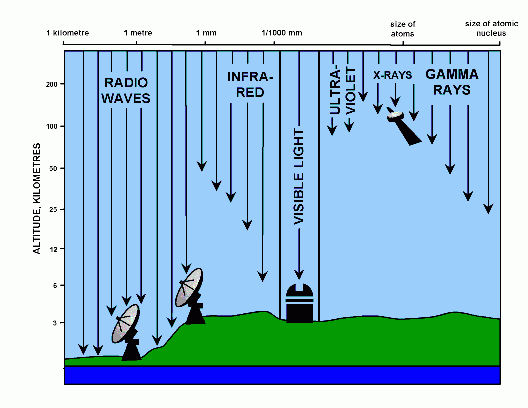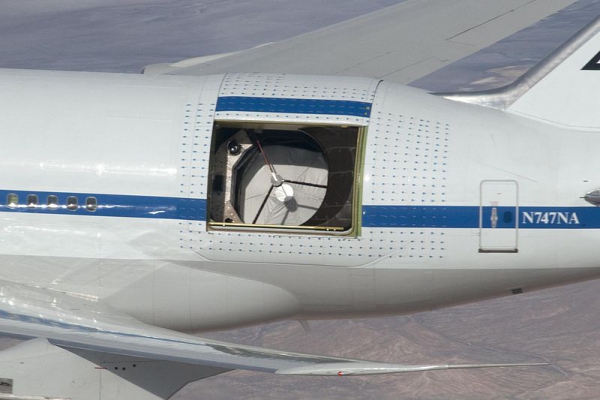by Thijs Kouwenhoven
- Published: Friday, April 04 2014 14:00
Have you ever imagined a telescope flying high in the sky? Probably not, but they do exist! The vast majority of telescopes are either ground-based or space-based, but there are also airborne observatories, such as telescopes on airplanes, on balloons, and on rockets. Ground-based telescopes can receive visible light and radio waves from space, but the Earth’s atmosphere is not transparent in other wavelengths, and such observations therefore have to be carried out at a place where the Earth’s atmosphere does not play an important role. Mountain tops are generally not high enough, and space-based satellites are very expensive. A good alterative is to mount a telescope on an aircraft, a balloon, or a rocket.
 Atmospheric transmission wavelength
Atmospheric transmission wavelength
Balloons can stay in the air for up to months, carry out observations up to 35 km height, and send the data back the ground station. Balloons are relatively cheap and don’t need a crew. A major disadvantage is that balloons follow the wind and may fly over the oceans or into other countries, and it may crash anywhere. These balloons are interpreted as UFOs by confused citizens who see the Sun’s light reflected.
Rockets can be used in the very high atmosphere. They go into space, but simply, carry out their observations, and then fall down again. This is much cheaper than sending a rocket into space, and observations (such as for X-ray and gamma-ray) can be taken from much higher altitudes than airplanes or balloons. Unfortunately, the observational time is short. Nevertheless, many important first astronomical results came from just those few minutes of observations. It is not completely clear where rockets crash after their mission, and one has to be careful that neighboring countries are not offended by a rocket launch.
Telescopes on airplanes are the most common airborne observatories. Unlike for balloons and rockets, the scientific instruments are not destroyed at the end of the mission, such that much more expensive telescopes can be used. Airplane crew can operate the telescope, the flight path can be adjusted, and repairs and upgrades are possible after landing. The airplane can be flown to different geographic locations for optimal sky coverage, longer observations can be carried out by flying westward. Flight paths must be carefully planned to avoid commercial and military air traffic, national borders, and bad weather. Airplanes are also more expensive than balloons, and cannot go as high as rockets. Nevertheless, they are the most successful among the airborne observatories.
As soon as the airplane was invented, astronomers started observing the Universe from high altitudes. From the 1920’s to the 1960’s they mostly focused on observing solar eclipses from airplanes, to study the Solar corona, measure the Moon’s orbit, measure the Earth’s geography. Among the first airborne astronomy attempts were the solar eclipse observations of 10 September 1923 carried out by Captain Albert W. Stevens of the USA Army Air Corps, the pioneer in airborne astronomy. Photographic plates were exposed to capture the eclipse, but all of them failed. Scientifically, the mission was a complete failure, but it gained a lot of interest among scientists and the general public. As technology of aircraft and detectors improved, the following decades provided great improvements, such as faster and higher airplanes, motion pictures, spectrographs, polarization filters, and mid-infrared detectors.
A breakthrough occurred in the 1960’s, after the invention of mid-infrared sensors and jet aircraft. Astronomers could now carry out observations from the high, dry, and cold heights of the atmosphere, and could study stars and galaxies for the first time in mid-infrared wavelengths. The Nuclear Test Ban Treaty, which prevents testing atmospheric nuclear bombs, was signed in the 1960’s. Although the USA obeyed this treaty, the Los Alamos Scientific Laboratory was ordered to keep the nuclear aircraft in operation, “just in case”. It was decided that the aircraft could be used temporarily for astronomy. Other countries decided to do the same, and an international fleet of seven aircraft observed the solar eclipse of 30 May 1965, now also supported by astronomical rocket observations.
After this success, the recently founded NASA decided to purchase an aircraft that was fully dedicated to astronomy: Galileo. In 1965, Galileo for the first time made successful observations of other celestial objects, including planets and moons in our Solar system. Among the scientists on board was Gerard Kuiper, who took near-infrared spectra of Venus, and discovered that the clouds of Venus are not made of water. Galileo tragically ended during a mid-air collision in 1973. Following the enormous success of Galileo, several more airborne observatories were built by the Atomic Energy Commission and NASA, including the Learjet aircraft, which flew at an altitude of more than 15 kilometers, allowing accurate near-, mid-, and far-infrared observations. French and British astronomers used the faster-than-sound Concorde airplane to observe the solar eclipse on 30 June 1973. With a velocity of over 2100 km/h, they followed the shade of the Moon, and observed the eclipse for 74 minutes, the longest ever.
 Kuiper Airborne Observatory and SOFIA
Kuiper Airborne Observatory and SOFIA
NASA’s next step was the construction of the Kuiper Airborne Observatory (KAO), named after Gerard Kuiper. The airplane was much larger and hosted a large telescope and twenty crew and had a flight time of 7.5 hours. From 1974 to 1995, KOA operated ~70 research flights per year, and studied planets, moons, galaxies, and interstellar gas. KAO stopped operation in 1995 after a long life of scientific discoveries.
Although many space observatories were launched in the last decades, airborne telescopes are still substantially cheaper, and several very successful projects have been carried out, including the Stratospheric Observatory for Far Infrared Astronomy (SOFIA). SOFIA is a 2.5-meter telescope mounted on a Boeing 747, designed for Mid- and Far-Infrared observations. The mission is a collaboration between the DLR (Germany) and NASA. It commenced its first test flight in 2007 and astronomical observations started in 2010, almost ten years later than the planned date, but with great success. SOFIA can carry out more than a hundred flights per year, and is the most advanced airborne observatory to date. Unfortunately, there was bad news a few weeks ago. On 4 March 2014 the White House announced that funding for SOFIA would be cut by 85%, and that SOFIA should seek the missing funds from international partners. If these funds are not found, the airplane may return to the hangar, or may be sold. It is sad news that after almost a hundred years of airborne astronomy, last month marked the end of the largest airborne observatory in history. However, there is hope, and perhaps the next generation of airborne telescopes will be built in a larger airplane, maybe even the Airbus 380!
# # #
 Thijs Kouwenhoven is a research professor at the Kavli Institute for Astronomy and Astrophysics at Peking University. He was born and raised in the Netherlands. He obtained is undergraduate degree at Leiden Observatory and his PhD degree at the University of Amsterdam. His research interests include planetary systems dynamics, the formation and evolution of star clusters, and binary/multiple stellar systems.
Thijs Kouwenhoven is a research professor at the Kavli Institute for Astronomy and Astrophysics at Peking University. He was born and raised in the Netherlands. He obtained is undergraduate degree at Leiden Observatory and his PhD degree at the University of Amsterdam. His research interests include planetary systems dynamics, the formation and evolution of star clusters, and binary/multiple stellar systems.










Comments